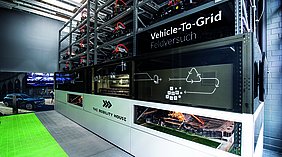
The technology company The Mobility House – together with partners at the EUREF Campus in Berlin – has for the first time ever demonstrated the potential of aggregated vehicle batteries in the energy market by means of real applications on the European power exchange (EPEX Spot). Extrapolated to one year, thousands of euros in revenues could be generated per vehicle. Taking into account deductions in the form of tax obligations, among other things, this results in potential savings of at least EUR 650 for end customers.
Unlike previous simulations, this trial used real electric car batteries, real consumption and charging profiles, and actual market behavior to market flexibility from electric vehicles. The tests alternated between “V1G” – shifting the charging process from a purely temporal perspective – and Vehicle-to-Grid (“V2G”) – the possibility of charging and discharging the batteries bidirectionally. Control was provided by The Mobility House’s smart and specifically developed software, which used algorithms to regulate the batteries’ state of charge and market their aggregated flexibility to the energy markets. In addition to the revenue potential in the energy market, the driver’s mobility requirements, the degradation of the battery and the upstream grid or mains connection were also taken into account.
Working in cooperation with AUDI AG, The Mobility House already set up a stationary storage system consisting of 20 Audi e-tron second-life batteries at the EUREF Campus in Berlin back in 2019. Since then, the multi-use storage solution has been used with various energy products.
Trading under real conditions
During the trial, 18 AUDI e-tron vehicle batteries from the stationary EUREF storage facility were treated as if they were used in mobile electric vehicles. A driving profile based on German average values was stored in the second-life batteries for this purpose. Each battery could be charged or discharged at 11 kW during the plug-in windows and consumed an amount of electricity equivalent to approximately 18,250 km of driving per year during the driving windows. The charging and discharging strategy took into account minimum storage levels when starting, among other things, and conserved the battery. During times when vehicles were typically plugged in for charging, the flexibility inherent in battery charging and discharging could be made available to the power system. At times when the vehicles were usually running, they were not available to the energy market. Using The Mobility House’s technology, several energy markets (day-ahead and intraday markets) were taken into account simultaneously so as to achieve the best possible values and savings at each point in time.
“The revenues generated during this field trial by our algorithms impressively demonstrate just how valuable bidirectional charging is. We are working t on products to tap into these values for our customers and thereby make electric cars’ tremendous storage capacity available to the energy system. To make this possible, regulatory obstacles must now be removed and the existing potential in the smart charging segment must not literally be left lying or standing in the street,” explained Marcus Fendt, Managing Director of The Mobility House.
Contact:
Manuela Niklasch, +49 89 4161 430-34, E: communication@mobilityhouse.com
E-world: Hall 5 Booth 412
About ‘The Mobility House’
The goal of The Mobility House is to shape an emission-free energy and mobility future. We integrate vehicle batteries into the power grid using intelligent charging and energy solutions. This way, we promote the development of renewable energies, stabilize the power grid, and make electric mobility more affordable. The technology company was founded in 2009 and operates globally from its sites in Munich, Zurich and Belmont (CA). We support our private and business customers on their way to electromobility through the planning and building process as well as the operation of an individual charging infrastructure. As a neutral supplier, we work together with many partners such as charging infrastructure manufacturers, installation companies, back-end system operators, energy suppliers and automobile manufacturers. Our intelligent Charging and Energy Management system ChargePilot and the underlying EV Aggregation Platform enable our customers and partners to integrate electric vehicles into the energy system in a way that is both beneficial and future-proof. For more information visit mobilityhouse.com.